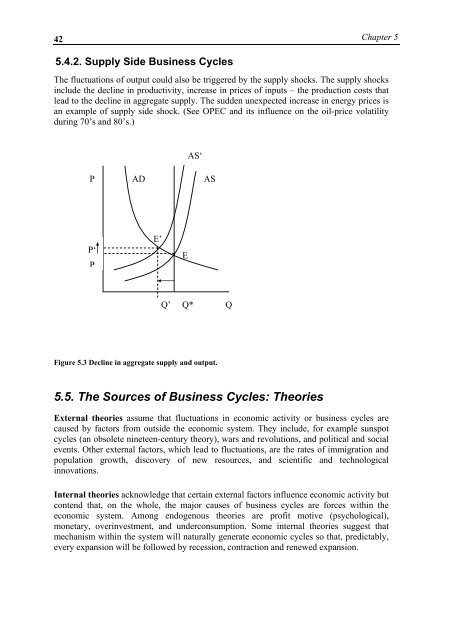MacroeconomicsI_working_version (1)
Create successful ePaper yourself
Turn your PDF publications into a flip-book with our unique Google optimized e-Paper software.
42<br />
Chapter 5<br />
5.4.2. Supply Side Business Cycles<br />
The fluctuations of output could also be triggered by the supply shocks. The supply shocks<br />
include the decline in productivity, increase in prices of inputs – the production costs that<br />
lead to the decline in aggregate supply. The sudden unexpected increase in energy prices is<br />
an example of supply side shock. (See OPEC and its influence on the oil-price volatility<br />
during 70’s and 80’s.)<br />
AS‘<br />
P<br />
AD<br />
AS<br />
P‘<br />
P<br />
E’<br />
E<br />
Q’<br />
Q*<br />
Q<br />
Figure 5.3 Decline in aggregate supply and output.<br />
5.5. The Sources of Business Cycles: Theories<br />
External theories assume that fluctuations in economic activity or business cycles are<br />
caused by factors from outside the economic system. They include, for example sunspot<br />
cycles (an obsolete nineteen-century theory), wars and revolutions, and political and social<br />
events. Other external factors, which lead to fluctuations, are the rates of immigration and<br />
population growth, discovery of new resources, and scientific and technological<br />
innovations.<br />
Internal theories acknowledge that certain external factors influence economic activity but<br />
contend that, on the whole, the major causes of business cycles are forces within the<br />
economic system. Among endogenous theories are profit motive (psychological),<br />
monetary, overinvestment, and underconsumption. Some internal theories suggest that<br />
mechanism within the system will naturally generate economic cycles so that, predictably,<br />
every expansion will be followed by recession, contraction and renewed expansion.




